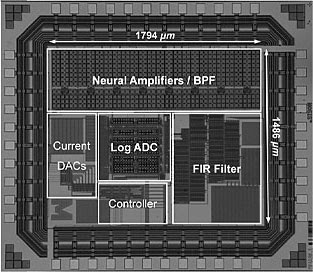Cyborgs Unite: Brain Implants/Interfaces Advance
 Two recent improvements in the technology of brain implants and interfaces suggest that the age of the cyborg is not far off. First, researchers at the University of Michigan have devised a neurochip that can simultaneously record from the brain AND stimulate the brain to subdue abnormal Parkinson's Disease motor activity. This new chip is able to modify its stimulation appropriately for the brain activity it senses.
Two recent improvements in the technology of brain implants and interfaces suggest that the age of the cyborg is not far off. First, researchers at the University of Michigan have devised a neurochip that can simultaneously record from the brain AND stimulate the brain to subdue abnormal Parkinson's Disease motor activity. This new chip is able to modify its stimulation appropriately for the brain activity it senses.Kipke and his colleagues have designed a system that integrates neural recordings from eight electrodes and uses them to program the amplitude, repetition rate, and duration of pulse generation in a 64-channel stimulator. Their goal is to get every component of the design onto a single chip, including the amplifier that connects to the probe, the data circuits, the digital filters, and the microprocessor that decides if, how, and when to stimulate. For now, however, the microprocessor is separate from the rest of the system, which resides on its own chip. “A microprocessor gives information to the chip about where and how, and the chip takes care of the rest,” says Michael Flynn, a leader of the project.Devices that can "read" the ongoing neural activity of the brain, can also tell the operator precisely where to place the electrodes, theoretically.
In theory, a device like this could automatically detect side effects or poor performance and change the pattern of stimulation. But the obvious question is, what recordings will give you this information? Where are you going to put these eight electrodes, and what are they going to tell you?...It’s a question that no one in the field is ready to answer because, as Vitek points out, we don’t even really know how deep-brain stimulation works when everything goes right. __IEEESpectrum_via_BrainStimulant
Meanwhile, University of Florida researchers have developed a "system" that learns along with the brain by allowing two-way communication via brain implant between the motor cortex and the computer integrator. Brains can learn to control remote hardware devices, and also theoretically re-learn control of muscles.
Fitted with tiny electrodes in their brains to capture signals for the computer to unravel, three rats were taught to move a robotic arm toward a target with just their thoughts. Each time they succeeded, the rats were rewarded with a drop of water.In other words, the rats are learning to use the interface, and the computer is learning at the same time how to react better to the neural input. Feedback response to both rat and computer will facilitate training of both. Fascinating.
The computer's goal, on the other hand, was to earn as many points as possible, Sanchez said. The closer a rat moved the arm to the target, the more points the computer received, giving it incentive to determine which brain signals lead to the most rewards, making the process more efficient for the rat. The researchers conducted several tests with the rats, requiring them to hit targets that were farther and farther away. Despite this increasing difficulty, the rats completed the tasks more efficiently over time and did so at a significantly higher rate than if they had just aimed correctly by chance, Sanchez said. __Source_via_NextBigFuture
In new, advanced brain implants, the implant guides placement of its own electrodes and is able to compensate for minor misplacement. Advanced implants listen to the brain, and learn to respond appropriately to the signals they sense from neural tissue. In the case of implants for Parkinson's or Alzheimer's, the hardware device can modify neural activity--subduing some impulses, amplifying others, nullifying others entirely, or creating stimuli de novo as needed.
Sophisticated stimulus, response, reward feedback systems can train the brain and the implant simultaneously. The next generations of these tools will allow brains to control remote devices via thought, and will allow damaged brains to regain control of their bodies and minds.
Of course, where there's a cyborg, you may also find a grobyc. Hold on tight to your brains.
Labels: cyborgs, electromagnetic brain stimulators, neural implants, silicon brain

3 Comments:
People who master a tool like a fencing sword, a paint brush, or a scalpel often describe the feeling of the tool being an extension of the self; it is felt to be part of them. I suspect that direct connection between brain and machine will be somewhat easier than some people assume and will have an effect on how we perceive our "self".
True. Then there is the curious phenomenon of "neglect" where a person denies that his own arm or leg is a part of his body.
Fascinating thing, the brain.
They had a monkey playing a game with his mind. Funny thing was when he realized the joystick wasn't doing anything anymore and stopped using it.
Alternatively, in Japan they have an external sensor:
http://www.cyberdyne.jp/English/index.html
This has the advantage of not needing surgery, an issue for the older people that would be able to best use the interface technology. Right now however, they're only reading the muscles in general, and so I'm not sure if there'd be enough resolution to do a whole lot of extra stuff. It is something I plan to study however, once I'm done with my EE and can qualify for the research student program for the university he works for.
Post a Comment
“During times of universal deceit, telling the truth becomes a revolutionary act” _George Orwell
<< Home